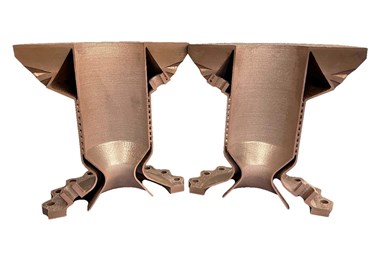Velo3D Qualifies Copper Alloy for Use With Its Sapphire Printers
Velo3D has qualified the NASA-developed GRCop-42 alloy for use with its Sapphire family of printers to deliver the conductivity of copper with high strength for aerospace applications, such as rocket engine combustion chambers.

A cross-sectioned thrust chamber printed on a Velo3D Sapphire system in GRCop-42. The chamber walls contain internal channels for regenerative cooling. Photo Credit: Velo3D
Velo3D has qualified the copper-chromium-niobium alloy GRCop-42 for use in its Sapphire family of printers. The alloy was developed by NASA for users to manufacture parts in need of high-strength and high-conductivity, such as rocket engine combustion chambers with regenerative cooling.
According to the company, Velo3D customers can use the developed material parameters to produce mission-critical parts with oxidation resistance and high creep strength at temperatures as high as 1,400°F.
“Our end-to-end solutions have seen extensive adoption in aerospace because of their ability to deliver part consolidation, lighter weight systems and unique geometries,” says Benny Buller, Velo3D CEO and founder. “And adding GRCop-42 to our growing list of available materials enables us to support more use cases across the aerospace industry.”
The company says it has had extensive demand for Sapphires and Sapphire XCs that can print GRCop-42 and it has tested the alloy to ensure it can achieve the same high-quality builds as its other materials.
GRCop-42 was developed by NASA in 1987 for use in harsh environments that are commonly found in rocket engine combustion chambers. The alloy was created after research teams identified ways to make improvements to previously developed copper alloys. It is said GRCop-42 stood out due to its ability to achieve higher thermal conductivity compared to its predecessor while achieving similar strength properties. In 2017, NASA developed parameters for GRCop-42’s use in additive manufacturing (AM) at its Marshall Space Flight Center in Alabama and Glenn Research Center in Ohio.
“Our team is always looking for new ways to differentiate our business and because of that we were an early adopter of additive manufacturing technology, which has helped us grow our business and better serve our customers,” says Mike Corliss, Knust Godwin vice president of technology. “Additive manufacturing allows us to build parts for our customers that could not otherwise be manufactured using conventional, subtractive manufacturing. These new, powerful alloys, like GRCop-42 — that provide added capabilities and benefits for our customers — allow us to expand our addressable use cases.”
Related Content
-
3D Printed "Evolved Structures" for NASA Exoplanet Balloon Mission: The Cool Parts Show #61
Generative design creates stiff, lightweight brackets for EXCITE mission monitoring planets orbiting other stars. The Cool Parts Show visits Goddard Space Flight Center.
-
3 Points About 3D Printing Large Parts We Can Learn From the Lunar Habitat (Video)
Ingersoll Machine Tools describes the capabilities and promise of large-scale additive manufacturing as seen in the 3D printed sections of the Rosenberg Space Habitat.
-
8 Transformations 3D Printing Is Making Possible
Additive manufacturing changes every space it touches; progress can be tracked by looking for moments of transformation. Here are 8 places where 3D printing is enabling transformative change.










.png;maxWidth=300;quality=90)





